
Daegu, formerly spelled Taegu and officially Daegu Metropolitan City, is a city in southeastern South Korea.
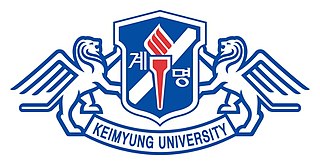
Keimyung University, abbreviated as KMU or Keimyung (啓明), is a private university located in Daegu, the fourth largest city in South Korea. The university was founded in 1954 with the support of the leaders of the Northern Presbyterian Church of the U.S. as a Christian university. KMU is composed of three campuses in the city of Daegu, South Korea. They are named for their locations within the city; Daemyeong, which is near the downtown area, Seongseo, which is in the western part of the city, and also Dongsan campus which includes Dongsan Medical Center.
Russians in Korea do not form a very large population, but they have a history going back to the Korean Empire. The community of Russian subjects/citizens in Korea has historically included not just ethnic Russians, but members of minority groups of Russia as well, such as Tatars, Poles, and, more recently, return migrants from among the Koryo-saram and Sakhalin Koreans.

The Muyejebo is the oldest extant Korean martial arts manual, compiled by Han Gyo (韓嶠) in 1598 during the reign of King Seonjo. With the addition of material from Japanese martial arts, a supplement, Sequel to the Book of Martial Arts (무예제보번역속집), compiled by Choi Ki-nam, was published in 1610.

Daegu station is a station on the Gyeongbu Line and Daegu Metro Line 1 in Chilseong-dong, Buk District, Daegu, South Korea.

Keisung Academy (계성고등학교) is a co-educational independent day and boarding school for grades 10–12, located in Daegu, South Korea.

National University of Education Station is an underground station of Daegu Subway Line 1 in Daemyeong-dong, Nam District, Daegu, South Korea. It is named for Daegu National University of Education. It is the first station of a city railroad of Daegu connected with this college.

Myeongdeok Station is a station of Metro Line 1 and Metro Line 3 in Namsan-dong, Jung District, Daegu, South Korea. On March 13, 2009, an entrance elevator was installed. There is connection track to the No. 2 subway line between Banwoldang station and Myeongdeok station.
Hengso Museum is a museum that belongs to Keimyung University that is located in Daegu, South Korea. The museum opened in May 1978. And in May 2004, it was rebuilt as new start point. The museum is not opened every Sunday.
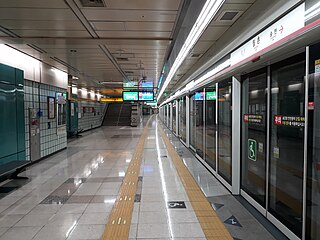
Wolchon Station is an underground of Line 1 of the Daegu Metro in Dalseo District, Daegu, South Korea.

Cheongna Hill Station is a station of Daegu Subway Line 2 and Line 3 in Daesin-dong, Dongsan-dong, and Namsan-dong, Jung District, Daegu, South Korea.
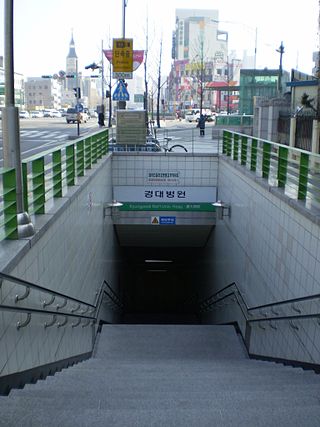
Kyungpook National University Hospital station is a station of Daegu Metro Line 2 in Samdeok-dong, Daebong-dong, Jung District, Daegu, South Korea.
Korean Language Institute offered by Keimyung University, is located in Daegu of 2.5 million people and one of Korea’s top three cities. provides comprehensive Korean education program for students from different countries. The overall goal of this program is to help the students foster a better understanding of the Korean spirit, heritage and Korean history. The campus is two hours by metro from downtown Seoul.
Acta Koreana is a biannual peer-reviewed academic journal covering Korean studies published in English by Academia Koreana. It was established in 1998 as an annual publication; since 2002 it has been published biannually.
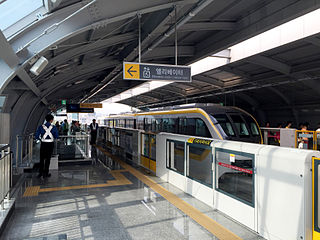
Seomun Market Station is a station of Daegu Subway Line 3 in Daesin-dong, and Sijangbungno, Jung District, Daegu, South Korea. It is named after Seomun Market, and is also called Dongsan Medical Center Station.
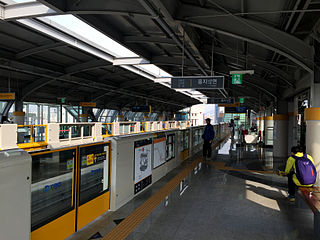
Namsan Station is a station of Daegu Subway Line 3 in Namsan-dong, and Namsanno, Jung District, Daegu, South Korea. It is named after Namsan-dong. Its station subname is Gyemyeongnegeori.

Kwon Jung Ho, also stylised as kwonjungho and Kwon Jungho, is a Korean artist, sculptor, and educator based in Daegu, South Korea. Kwon was influenced by Abstract Expressionism, Neo-Expressionism, and Post-Modernism movements. A majority of artworks in the oeuvre take the shape of the skeleton that reflects the artist's interest in the subject matters of life and death inspired by his physician father from a childhood memory. The pivotal artworks consist of monochrome paintings, dot series, sound series, skeleton series that embrace flat painting and installation, and conception and abstraction.













